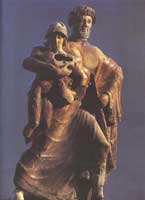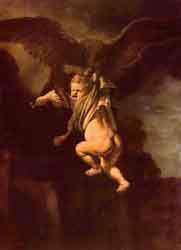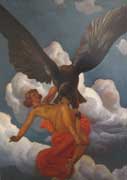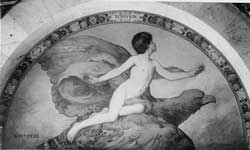This Erichthonius had a son Tros,
who ruled the Trojans, and Tros then fathered
three outstanding sons—Ilus, Assaracus,
and godlike Ganymede, the handsomest man
among all mortal men, so beautiful,
gods kidnapped him and made him cup bearer
to Zeus himself, so he'd live among immortals.
Homer, Iiad Book 20
In Greek mythology, Ganymede (Greek: Γανυμήδης, Ganumêdês)) was a divine hero whose homeland was the Troad. As a beautiful Trojan prince, son of eponymous Tros himself (or Laomedon?), Ganymede became Zeus's lover and cupbearer to the gods. For the etymology of his name (The Greek Myths: The Complete And Definitive Edition , Robert Graves) offers ganuesthai + medea, "rejoicing in virility."
Story
Ganymede was kidnapped by Zeus from Mount Ida in Phrygia, the setting for more than one myth-element bearing on the early mythic history of Troy. Ganymede was there, passing the time of exile many heros undergo in their youth, by tending a flock of sheep or, alternatively, during the chthonic or rustic aspect of his education, while gathering among his friends and tutors. Zeus saw him and fell in love with him instantly, either sending an eagle or assuming his own eagle nature to transport Ganymede to Mount Olympus.
Ganymede was Trojan not Greek, a fact of his origin that identifies him as part of the earliest, pre-Hellenic level of Aegean myth. Plato's Timaeus was of the opinion that the Ganymede myth had been invented by the Cretans— Minoan Crete being a power center of pre-Greek culture— to account for their pederastic lusts, which were imported thence into Greece, the Greek authors righteously agree. Homer doesn't dwell on the erotic aspect of Ganymede's abduction, but it is certainly in an erotic context that the goddess refers to Ganymede's blond Trojan beauty in the Homeric Hymn to Aphrodite, mentioning Zeus' love for Trojan Ganymede as part of her enticement of Trojan Anchises.
The Roman poet Ovid adds vivid detail - and veiled irony directed against critics of male love: aged tutors reaching out to grab him back, and Ganymede's hounds barking uselessly at the sky (Carmina, x). Statius' Thebaid I:549 describes a cup worked with Ganymede's iconic mythos:
"Here the Phrygian hunter is borne aloft on tawny wings, Gargara’s range sinks downwards as he rises, and Troy grows dim beneath him; sadly stand his comrades; vainly the hounds weary their throats with barking, pursue his shadow or bay at the clouds."
In Olympus, Zeus made Ganymede his lover and cupbearer, supplanting Hebe. All the gods were filled with joy to see the youth, save Hera, Zeus' consort, who despised Ganymede. Her hate of him was applied by mythographers to account for her abandoning the Trojans, an otherwise inaccountable shift in the alliances of the Trojan War, for the Troad was part of the homeland of the Great Goddess, of whom Hera was the main Olympian representative.
In a possible alternate version, the Titan Eos, dawn-goddess and connoisseur of male beauty, kidnapped Ganymede as well as her better-remembered consort, his brother Tithonus, whose immortality was granted, but not eternal youth. Tithonus indeed lived forever but grew more and more ancient, eventually turning into a cricket, a classic example of the myth-element of the Boon with a Catch. Tithonus is placed in the Dardanian lineage through Tros, an eponym for Troy, as Ganymede. Robert Graves (The Greek Myths) interpreted the substitution of Ganymede for Tithonus in a few references to the myth as a misreading of an archaic icon that would have shown the consort of the winged Goddess bearing a libation cup in his hand. (Compare the scholiast on Apollonius of Rhodes, iii:115; Virgil, Aeneid i:32; Hyginus, Fabula 224.)
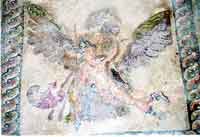
Ganymede Mosaic, Zeus carries the young man Ganymede (Ganymed) to Olympus,
Kato Paphos Archaeological Park, Mosaic, House of Dionysos, Paphos,
Ganymede's father grieved for his son. Sympathetic, Zeus sent Hermes to Tros with two horses so swift they could run over water. Hermes also assured Ganymede's father that the boy was now immortal and would be the cupbearer for the gods, a position of much distinction. The theme of the father recurs in many of the Greek coming-of-age myths of male love, suggesting that the pederastic relationships symbolized by these stories took place with the consent of the father.
Zeus later put Ganymede in the sky as the constellation Aquarius, which is still associated with that of the Eagle (Aquila).
In poetry, Ganymede was a symbol for the ideally beautiful youth and also for pederastic love, sometimes contrasted with Helen of Troy in the role of symbol for the love of women.
In Rome the passive object of a man's same-sex desire was a catamite (catamitus). The word is a corruption of Greek ganymedes but it has no mythological connotation in Latin. When Ovid sketches the myth briefly (Metamorphoses x:152-161), "Ganymedes" retains his familiar Greek name.
Ganymede in ancient arts

In Athens, vase-painters often depicted the mythological story, which was so suited to the all-male symposium or formal banquet. The Ganymede myth was treated in recognizable contemporary terms, illustrated with common behavior of homoerotic courtship rituals. On an Attic red-figure vase in the Louvre, Zeus pursues Ganymede on one side, while on the other side the youth runs away, rolling along a hoop while holding aloft a crowing cock (presumably a courtship gift from Zeus) [1] On a vase by the "Achilles Painter" Ganymede also flees with a cock. Ganymede is usually depicted as a well-developed, muscular youth, albeit one engaged in incongruously infantile activities (such as rolling a hoop down the street.)
Leochares (about B.C. 350), a Greek sculptor of Athens who was engaged with Scopas on the Mausoleum at Halicarnassus cast a bronze group of Ganymede and the Eagle, a work remarkable for its ingenious composition, which boldly ventures to the verge of what is allowed by the laws of sculpture, and also for its charming treatment of the youthful form as it soars into the air. It is apparently imitated in a well-known marble group in the Vatican, half life-size. Such Hellenistic gravity-defying feats were influential in the arts of the Baroque.
Vollmer's Wörterbuch der Mythologie aller Völker (Stuttgart, 1874) illustrates "Ganymede" by an engraving of a "Roman relief," showing a seated bearded Zeus who holds the cup aside in order to draw a naked Ganymede into his embrace. That engraving however was nothing but a copy of Anton Meng's counterfeit Roman fresco, painted as a practical joke on the eighteenth century art critic Johann Winckelmann who was growing desperate in his search for homoerotic Greek and Roman antiquities.
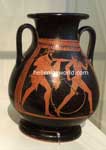
A. Zeus and Ganymede, Pelike, 470-460 B.C.

Zeus and Ganymede. Penthesilea Painter, 450 BC, Museo Archeologico Nazionale, Ferrara
Renaissance and Baroque Ganymede
In Shakespeare's As You like It (1599), a comedy of mistaken identity in the magical setting of the Forest of Arden, Celia, dressed as a shepherdess, becomes "Aliena" ("stranger") and Rosalind, because she is "more than common tall", dresses up as a boy, Ganymede, a well-known image to the audience. She plays on her ambiguous charm to seduce Orlando, but also (involuntarily) the shepherdess Phebe. Thus behind the conventions of Elizabethan theater in its original setting, the young boy playing the girl Rosalind dresses up as a boy and is then courted by another boy playing Phebe.

Ganymed, Antonio Allegri "Correggio"
When painter-architect Baldassare Peruzzi includes a panel of The Rape of Ganymede in a ceiling at the Villa Farnesina, Rome, (ca 1509-1514), Ganymede's long blond hair and girlish pose make him unidentifiable at first glance, though he grasps the eagle's wing without resistance. In the version by Antonio Allegri "Correggio" (1439/1534),(Vienna), Ganymede's grasp is more intimate.
Rubens' version (see illustration above) portrays a full-fleshed young country lad. But when Rembrandt paints the Rape of Ganymede for a Calvinist Dutch patron in 1635, the Classical erotic overtones are given a scathing twist: the dark eagle carries aloft a plump cherubic baby (Paintings Gallery, Dresden), one who is crying and pissing in fright. This is a pictographic formulation of the ancient condemnation of pederasts - that they prey on little children.
At Chatsworth in the 19th century the bachelor Duke of Devonshire added to his sculpture gallery Adamo Tadolini's Neoclassic "Ganymede and the Eagle' in which a luxuriously reclining Ganymede, embraced by one wing, prepares to exchange a peck with the eagle. The delicate cup in his hand is made of gilt-bronze, lending an unsettling immediacy and realism to the white marble group.
In the early years of the twentieth century, the topos of Ganymede's abduction by Zeus was drafted into the service of commercial enterprise. Basing themselves on a 1892 lithograph by F. Kirchbach, the brewery of Anheuser-Busch launched in 1904 an ad campaign publicizing the successes of Budweiser beer. Collectibles featuring the graphics of the poster continued to be produced into the early 1990's.
Moon
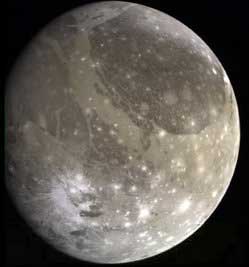
Jupiter's seventh and largest moon is named after Ganymede; see Ganymede (moon).
Shakespeare
Rosalind, a young woman in hiding, takes on the disguise of a man and the name of Ganymede in Shakespeare's comedy, As You Like It.
Ancient sources
Homer - Iliad 5.265; Iliad 20.232;
Homerica - The Little Iliad, Frag 7;
Hesiod - Catalogue of Women, Frag 40A (from Oxyr Papyri Frag 3);
The Homeric Hymns, 2nd Edition, Apostolos N. Athanassakis - Hymn V, To Aphrodite, 203-217;
Theognis - Fragments 1.1345;
Pindar - Olympian Odes 1; 11;
Euripides - Iphigenia at Aulis 1051;
Plato - Phaedrus 255;
Apollonios Rhodios - Argonautica 3.112f;
Apollodorus - The Library 2.104; 3.141;
Strabo - Geography 13.1.11;
Pausanias - Guide to Greece V.24.5; V.26.2-3;
Diodorus Siculus - The Library of History 4.75.3;
Hyginus
Fabulae 89; 224; 271;
Astronomica 2.16; 2.29;
Ovid - Metamorphoses 10.152;
Virgil - Aeneid 1.28; 5.252;
Cicero - De Natura Deorum 1.40;
Valerius Flaccus - Argonautica 2.414; 5.690;
Statius
Thebaid 1.549;
Silvae 3.4.13;
Apuleius - The Golden Ass 6.15; 6.24;
Quintus Smyrnaeus - Fall of Troy 8.427; 14.324;
Nonnus - Dionysiaca 8.93; 10.258; 10.308; 12.39; 14.430; 15.279; 17.76; 19.158; 25.430; 27.241; 31.252; 33.74; 39.67; 47.98;
Suidas - Ilion; Minos;
Links
The Rape of Ganymede, 1700, Anton Domenico Gabbiani ( 1652-1726), Galleria degli Uffizi, Florence
Ganymede , Benvenuto Cellini, 1545-47 Bronze, height: 62 cm Museo Nazionale del Bargello, Florence
Images: [2] (http://mapage.noos.fr/dardelf2/museum4/Ganymede.jpg), *[3] (http://www.psychodelicates.com/The%20Rape%20of%20Ganymede%20by%20Rubens.gif), *[4] (http://www.theoi.com/image/O24.6Ganymedes.gif), *[5] (http://gallery.euroweb.hu/art/m/michelan/4drawing/1cavali1.jpg)
Peter R. Griffith on the homoerotic symbology of Ganymede (http://www.glbtq.com/arts/subjects_ganymede.html)
More Images See
The Greek Myths: The Complete And Definitive Edition-, Robert Graves
See also : Greek Mythology. Paintings, Drawings
Greek Mythology Index
A - B - C - D - E - F - G - H - I - J - K - L - M -
N - O - P - Q - R - S - T - U - V - W - X - Y - Z
Α - Β - Γ - Δ - Ε - Ζ - Η - Θ - Ι - Κ - Λ - Μ -
Ν - Ξ - Ο - Π - Ρ - Σ - Τ - Υ - Φ - Χ - Ψ - Ω
Retrieved from "http://en.wikipedia.org/"
All text is available under the terms of the GNU Free Documentation License
| Ancient Greece
Science, Technology , Medicine , Warfare, , Biographies , Life , Cities/Places/Maps , Arts , Literature , Philosophy ,Olympics, Mythology , History , Images Medieval Greece / Byzantine Empire Science, Technology, Arts, , Warfare , Literature, Biographies, Icons, History Modern Greece Cities, Islands, Regions, Fauna/Flora ,Biographies , History , Warfare, Science/Technology, Literature, Music , Arts , Film/Actors , Sport , Fashion --- |

